America in the summer of 1919 ran red with blood from racial violence, and yet today, 100 years later, not many people know it even happened.
It flowed in small towns like Elaine, Arkansas, in medium-size places such as Annapolis, Maryland, and Syracuse, New York, and in big cities like Washington and Chicago. Hundreds of African American men, women and children were burned alive, shot, lynched or beaten to death by white mobs. Thousands saw their homes and businesses burned to the ground and were driven out, many never to return.
Click to Gallery
In 1919 alone, violence erupted in such places as New York; Memphis, Tennessee; Philadelphia; Charleston, South Carolina; Baltimore; New Orleans; Wilmington, Delaware; Omaha, Nebraska; New London, Connecticut; Bisbee, Arizona; Longview, Texas; Knoxville, Tennessee; Norfolk, Virginia; and Putnam County, Georgia.
America in the summer of 1919 ran red with blood from racial violence, and yet today, 100 years later, not many people know it even happened.
Beyond the lives and family fortunes lost, it had far-reaching repercussions, contributing to generations of black distrust of white authority. But it also galvanized blacks to defend themselves and their neighborhoods with fists and guns; reinvigorated civil rights organizations like the NAACP and led to a new era of activism; gave rise to courageous reporting by black journalists; and influenced the generation of leaders who would take up the fight for racial equality decades later.
"It doesn't fit into the neat stories we tell ourselves," said David Krugler, author of "1919, The Year of Racial Violence: How African Americans Fought Back."
The bloodshed was the product of a collision of social forces: Black men were returning from World War I expecting the same rights they had fought and bled for in Europe, and African Americans were moving north to escape the brutal Jim Crow laws of the South. Whites saw blacks as competition for jobs, homes and political power.
In 1919 alone, violence erupted in such places as New York; Memphis, Tennessee; Philadelphia; Charleston, South Carolina; Baltimore; New Orleans; Wilmington, Delaware; Omaha, Nebraska; New London, Connecticut; Bisbee, Arizona; Longview, Texas; Knoxville, Tennessee; Norfolk, Virginia; and Putnam County, Georgia.
It was branded "Red Summer" because of the bloodshed and amounted to some of the worst white-on-black violence in U.S. history.
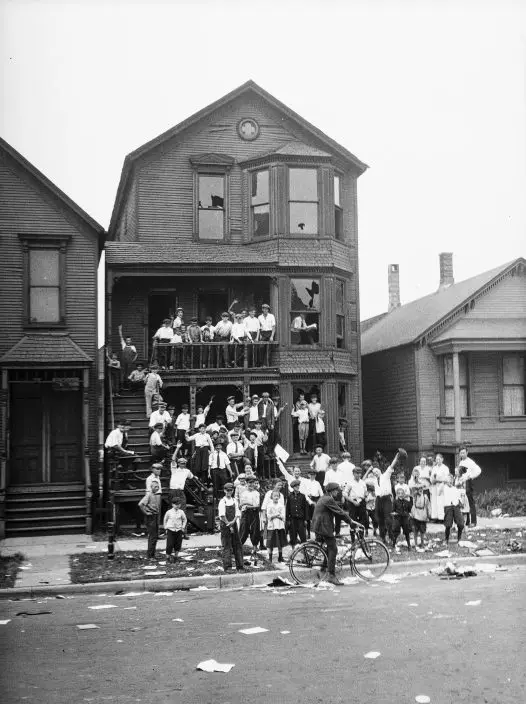
In this 1919 photo provided by the Chicago History Museum, a crowd gathers at a house that has been vandalized and looted during the race riots in Chicago. Some of the crowd is posing inside broken windows, others are standing on the lawn. Red Summer, as the summer of 1919 came to be known, saw white-on-black violence in big cities like Washington and Chicago and small towns like Elaine, Ark., and Bisbee, Ariz. (Chicago History MuseumThe Jun Fujita negatives collection via AP)
Beyond the lives and family fortunes lost, it had far-reaching repercussions, contributing to generations of black distrust of white authority. But it also galvanized blacks to defend themselves and their neighborhoods with fists and guns; reinvigorated civil rights organizations like the NAACP and led to a new era of activism; gave rise to courageous reporting by black journalists; and influenced the generation of leaders who would take up the fight for racial equality decades later.
"The people who were the icons of the civil rights movement were raised by the people who survived Red Summer," said Saje Mathieu, a history professor at the University of Minnesota.
For all that, there are no national observances marking Red Summer. History textbooks ignore it, and most museums don't acknowledge it. The reason: Red Summer contradicts the post-World War I-era notion that America was making the world safe for democracy, historians say.
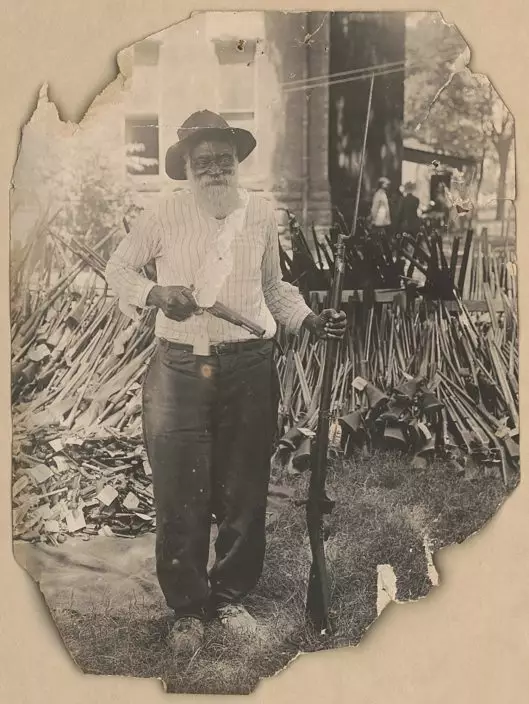
In this July 13, 1919 image provided by the Library of Congress, Daniel Hoskins stands with guns deposited at Gregg County Courthouse, in Longview, Texas, following race riots during Red Summer. Red Summer, as the summer of 1919 came to be known, saw white-on-black violence in big cities like Washington and Chicago and small towns like Longview. (Library of Congress via AP)
"It doesn't fit into the neat stories we tell ourselves," said David Krugler, author of "1919, The Year of Racial Violence: How African Americans Fought Back."
That could change. A monument has been proposed in Arkansas. Several authors have written about the bloody summer. A Brooklyn choral group performed Red Summer-theme songs like "And They Lynched Him on a Tree" in March to commemorate the centennial. At the National World War I Museum and Memorial in Kansas City, Mathieu and author Cameroon McWhirter plan to present some of their findings July 30 .
Researchers believe that in a span of 10 months, more than 250 African Americans were killed in at least 25 riots across the U.S. by white mobs that never faced punishment. Historian John Hope Franklin called it "the greatest period of interracial strife the nation has ever witnessed."
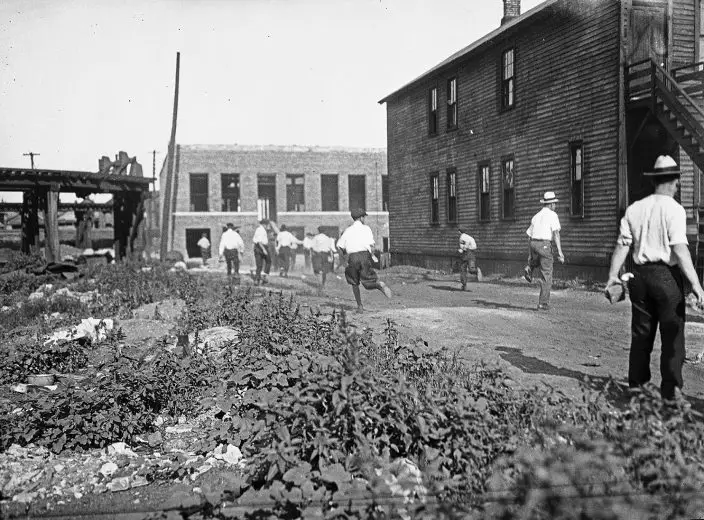
In this 1919 photo provided by the Chicago History Museum, a mob runs with bricks during the race riots in Chicago. Red Summer, as the summer of 1919 came to be known, saw white-on-black violence in big cities like Washington and Chicago and small towns like Elaine, Ark., and Bisbee, Ariz. (Chicago History MuseumThe Jun Fujita negatives collection via AP)
The bloodshed was the product of a collision of social forces: Black men were returning from World War I expecting the same rights they had fought and bled for in Europe, and African Americans were moving north to escape the brutal Jim Crow laws of the South. Whites saw blacks as competition for jobs, homes and political power.
"Ethnic cleansing was the goal of the white rioters," said William Tuttle, a retired professor of American studies at the University of Kansas and author of "Race Riot: Chicago in the Red Summer of 1919." ''They wanted to kill as many black people as possible and to terrorize the rest until they were willing to leave and live someplace else."
The violence didn't start or end in 1919. Some count the era of Red Summer as beginning with the deaths of more than two dozen African Americans in East Saint Louis, Missouri, in 1917 and extending through the Rosewood Massacre of 1923, when a black town in Florida was destroyed. All told, at least 1,122 Americans were killed in racial violence over those six years, by Tuttle's count.
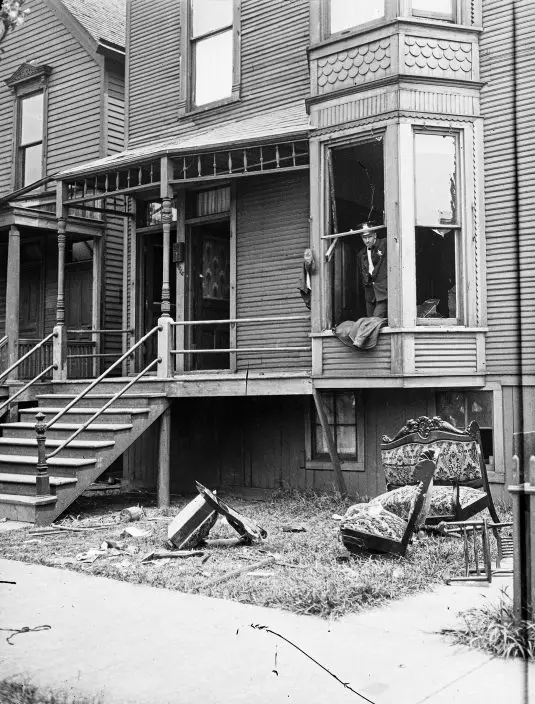
In this 1919 photo provided by the Chicago History Museum, police look through a broken window of a house during the race riots in Chicago. Broken furniture is strewn about the front yard. Hundreds of African Americans died at the hands of white mobs during “Red Summer,” as the summer of 1919 came to be known, but little is known nationally about this summer of violence 100 years later. (Chicago History MuseumThe Jun Fujita negatives collection via AP)
In 1919 alone, violence erupted in such places as New York; Memphis, Tennessee; Philadelphia; Charleston, South Carolina; Baltimore; New Orleans; Wilmington, Delaware; Omaha, Nebraska; New London, Connecticut; Bisbee, Arizona; Longview, Texas; Knoxville, Tennessee; Norfolk, Virginia; and Putnam County, Georgia.
In the nation's capital, white mobs — many made up of members of the military — rampaged over the weekend of July 19-22, beating any black they could find after false rumors of a white woman being assaulted by black men spread.
"In front of the Riggs Bank the rioters beat a Negro with clubs and stones wrapped in handkerchiefs; the bleeding figure lay in the street for over twenty minutes before being taken to the hospital," Lloyd M. Abernethy wrote in the Maryland Historical Magazine in 1963. "Sensing the failure of the police, the mob became even more contemptuous of authority — two Negroes were attacked and beaten directly in front of the White House."
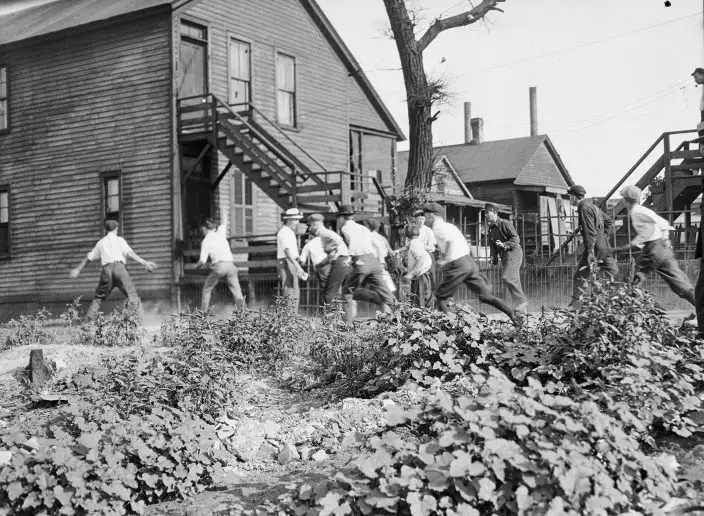
In this 1919 photo provided by the Chicago History Museum, a victim is stoned and bludgeoned under a corner of a house during the race riots in Chicago. Hundreds of African Americans died at the hands of white mobs during “Red Summer,” as the summer of 1919 came to be known, but little is known nationally about this summer of violence 100 years later. (Chicago History MuseumThe Jun Fujita negatives collection via AP)
Carter G. Woodson, the historian who founded Black History Month in 1926, saw the violence up close.
"They had caught a Negro and deliberately held him as one would a beef for slaughter, and when they had conveniently adjusted him for lynching, they shot him," Woodson wrote. "I heard him groaning in his struggle as I hurried away as fast as I could without running, expecting every moment to be lynched myself."
In Elaine, Arkansas, poor black sharecroppers who had dared to join a union were attacked, and at least 200 African Americans were killed.
Ida B. Wells, a pioneering black journalist and one of the few reporters to interview victims, noted a woman named Lula Black was dragged from her farm by a white mob after saying she would join the union.
"They knocked her down, beat her over the head with their pistols, kicked her all over the body, almost killed her, then took her to jail," Wells wrote in her report "The Arkansas Race Riot." "The same mob went to Frank Hall's house and killed Frances Hall, a crazy old woman housekeeper, tied her clothes over her head, threw her body in the public road where it lay thus exposed till the soldiers came Thursday evening and took it up."
Black journalists like Wells played an important role in getting the story out.
"Black newspapers like the Chicago Defender were instrumental in providing an alternate voice that represented why African Americans deserved to be here, deserved equal rights and were, in some cases, justified in fighting," said Kevin Strait, a curator at the Smithsonian National Museum of African American History and Culture.
Red Summer also marked a new era of black resistance to white injustice, with African Americans standing up in unprecedented numbers and killing some of their tormentors. Returning black soldiers from World War I led the charge, using skills they refined in Europe.
"The Germans weren't the enemy — the enemy was right here at home," said Harry Haywood in his autobiography, "A Black Communist in the Freedom Struggle: The Life of Harry Haywood."
In Washington, Carrie Johnson, 17, became a hero for shooting at white invaders in her neighborhood. She fatally shot a white policeman who broke into her second-story bedroom. She claimed self-defense, and her manslaughter conviction was overturned.
The NAACP gained about 100,000 members that year, said McWhirter, author of "Red Summer: The Summer of 1919 and the Awakening of Black America." Soon, blacks were "going to Congress, they're pressing congressmen and senators to pass anti-lynching legislation. At the same time, they're fighting back in the courts, they're filing lawsuits when people are being mistreated or railroaded."
The lessons of Red Summer would reverberate after World War II.
"You have a similar situation where African Americans had done their part to make the world safe for democracy, and black veterans came home, and many of them were alive or had heard the stories of what happened in 1919," Krugler said. "And they said, 'Never again.'"
Jesse J. Holland covers race and ethnicity for The Associated Press. Contact him at jholland@ap.org, on Twitter at http://www.twitter.com/jessejholland or on Facebook at http://www.facebook.com/jessejholland .
EDITOR'S NOTE: Hundreds of African Americans died at the hands of white mobs during "Red Summer." but little is known nationally about this summer of violence 100 years later. As part of AP's coverage plans for Red Summer, we will take a multiplatform look at those who were attacked and killed in cities and towns around the nation. https://www.apnews.com/RedSummer
VENICE, Italy (AP) — Under the gaze of the world’s media, the fragile lagoon city of Venice launched a pilot program Thursday to charge day-trippers a 5-euro (around $5.35) entry fee that authorities hope will discourage visitors from arriving on peak days and make the city more livable for its dwindling residents.
Visitors arriving at Venice's main train station were greeted with large signs listing the 29 dates through July of the plan's test phase, as well as new entrances separating tourists from residents, students and workers.
Stewards were on hand to politely guide anyone unaware of the new requirements through the process of downloading the QR code to pay the fee.
“We need to find a new balance between the tourists and residents,’’ said the city’s top tourism official, Simone Venturini. “We need to safeguard the spaces of the residents, of course, and we need to discourage the arrival of day-trippers on some particular days.”
Arianna Cecilia, who lives in Rome and was visiting Venice for the first time with her boyfriend, said it felt “strange" to have to buy a ticket to enter a city in her native Italy, and then pass through a tourist entrance.
The couple were staying in nearby Treviso, and had paid the fee and downloaded the QR code as required prior to arrival.
Workers in yellow vests carried out random checks at the train station, and anyone caught faces fines of 50 euros to 300 euros — though officials said “common sense” was being applied for the launch.
The requirement applies only for people arriving between 8:30 a.m. and 4 p.m. Outside of those hours, access is free and unchecked.
Venice has long suffered under the pressure of over-tourism, and officials hope the pilot project can help provide more exact figures to better manage the phenomenon.
The city can track the number of hotel visitors — which last year numbered 4.6 million, down 16% from pre-pandemic highs. But the number of day visitors, which make up the majority of the crowds in Venice, could only be estimated until recently.
A Smart Control Room set up during the pandemic has been tracking arrivals from cell phone data, roughly confirming pre-pandemic estimates of 25 million to 30 million arrivals a year, said Michele Zuin, the city’s top economic official. That includes both day-trippers and overnight guests.
But Zuin said the data is incomplete. “It’s clear we will get more reliable data from the contribution” being paid by day-trippers, he said.
Venturini said the city is strained when the number of day-trippers reaches 30,000 to 40,000. Its narrow alleyways are clogged with people and water taxis packed, making it difficult for residents to go about their business.
Not all residents, however, are persuaded of the efficacy of the new system in dissuading mass tourism. Some say more attention needs to be paid to boosting the resident population and services they need.
Venice last year passed a telling milestone when the number of tourist beds exceeded for the first time the number of official residents, which is now below 50,000 in the historic center with its picturesque canals.
“Putting a ticket to enter a city will not decrease not even by one single unit the number of visitors that are coming,’’ said Tommaso Cacciari, an activist who organized a protest Thursday against the measure.
“You pay a ticket to take the metro, to go to a museum, an amusement park; you don’t pay a ticket to enter a city. This is the last symbolic step of a project of an idea of this municipal administration to kick residents out of Venice,” he said.
Venturini said about 6,000 people had already paid to download the QR code, and officials expect paid day-tripper arrivals Thursday to reach some 10,000.
More than 70,000 others have downloaded a QR code denoting an exemption, including to work in Venice or as a resident of the Veneto region. People staying in hotels in Venice, including in mainland districts like Marghera or Mestre, should get a QR code attesting to their stay, which includes a hotel tax.
The tourist official says interest in Venice's pilot program has been keen from other places suffering from mass tourism, including other Italian art cities and cities abroad such as Barcelona and Amsterdam.
Marina Rodino, who has lived in Venice for 30 years, is opposed to the new plan. She was passing out mock EU passports for “Venice, Open City,” underlining the irony of the new system, and challenging its legal standing with citations from the Italian constitution guaranteeing its citizens the right to “move or reside freely in any part of the national territory."
Rodino has seen her local butcher close and families leave her neighborhood near the famed Rialto Bridge as short-term apartment rentals spring up. But she said the new entrance fee requirement will still allow young people to flood the city in the evening for often rowdy gatherings.
“This is not a natural oasis. This is not a museum. It is not Pompeii," she said. “It is a city, where we need to fight so the houses are inhabited by families, and stores reopen. That is what would counter this wild tourism.”
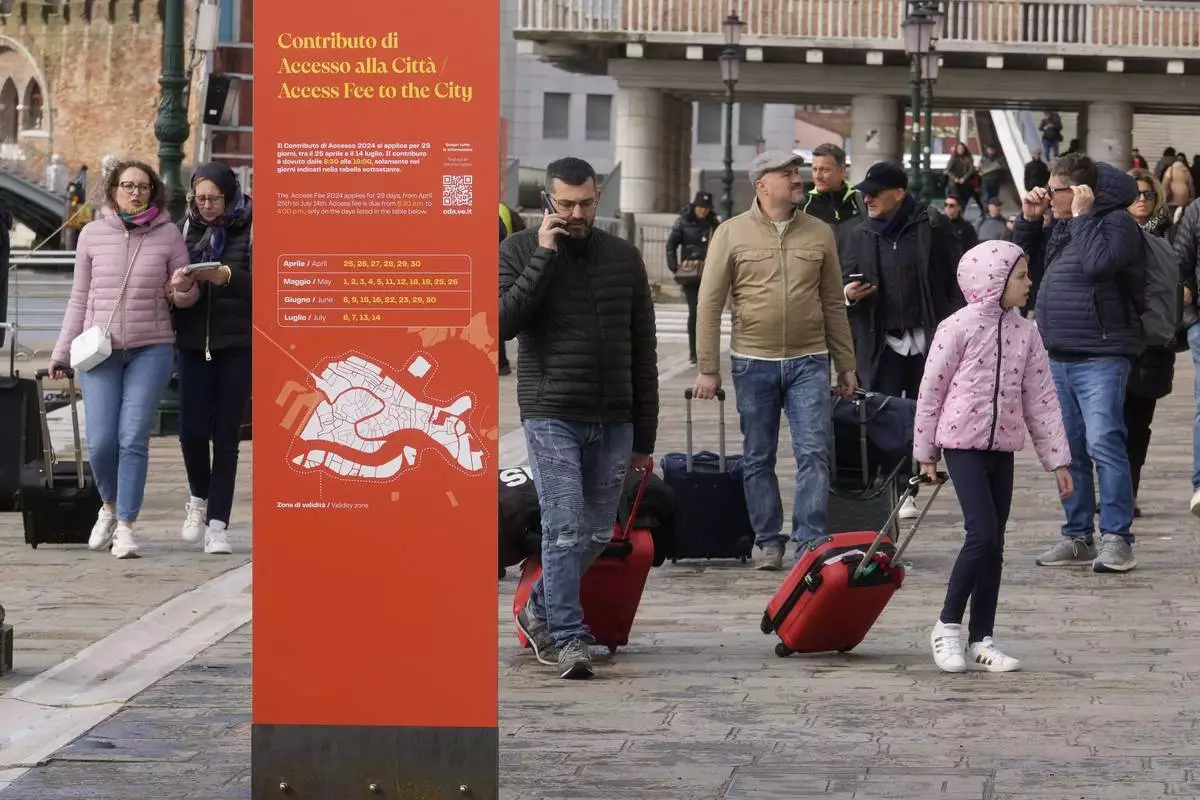
Tourists arrive in Venice, Italy, Thursday, April 25, 2024. The fragile lagoon city of Venice begins a pilot program Thursday to charge daytrippers a 5 euro entry fee that authorities hope will discourage tourists from arriving on peak days. The daytripper tax is being tested on 29 days through July, mostly weekends and holidays starting with Italy's Liberation Day holiday Thursday. Officials expect some 10,000 people will pay the fee to access the city on the first day, downloading a QR code to prove their payment, while another 70,000 will receive exceptions, for example, because they work in Venice or live in the Veneto region. (AP Photo/Luca Bruno)
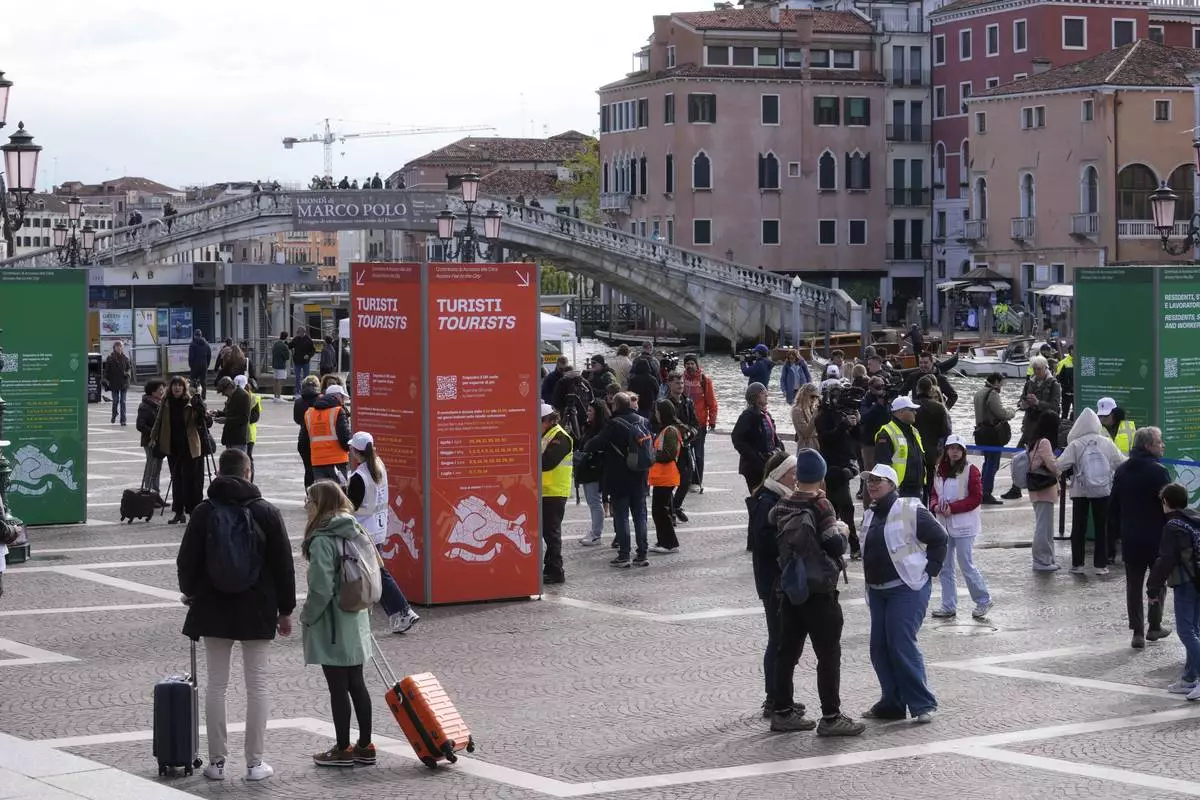
Stewards check tourists QR code access outside the main train station in Venice, Italy, Thursday, April 25, 2024. The fragile lagoon city of Venice begins a pilot program Thursday to charge daytrippers a 5 euro entry fee that authorities hope will discourage tourists from arriving on peak days. The daytripper tax is being tested on 29 days through July, mostly weekends and holidays starting with Italy's Liberation Day holiday Thursday. Officials expect some 10,000 people will pay the fee to access the city on the first day, downloading a QR code to prove their payment, while another 70,000 will receive exceptions, for example, because they work in Venice or live in the Veneto region. (AP Photo/Luca Bruno)
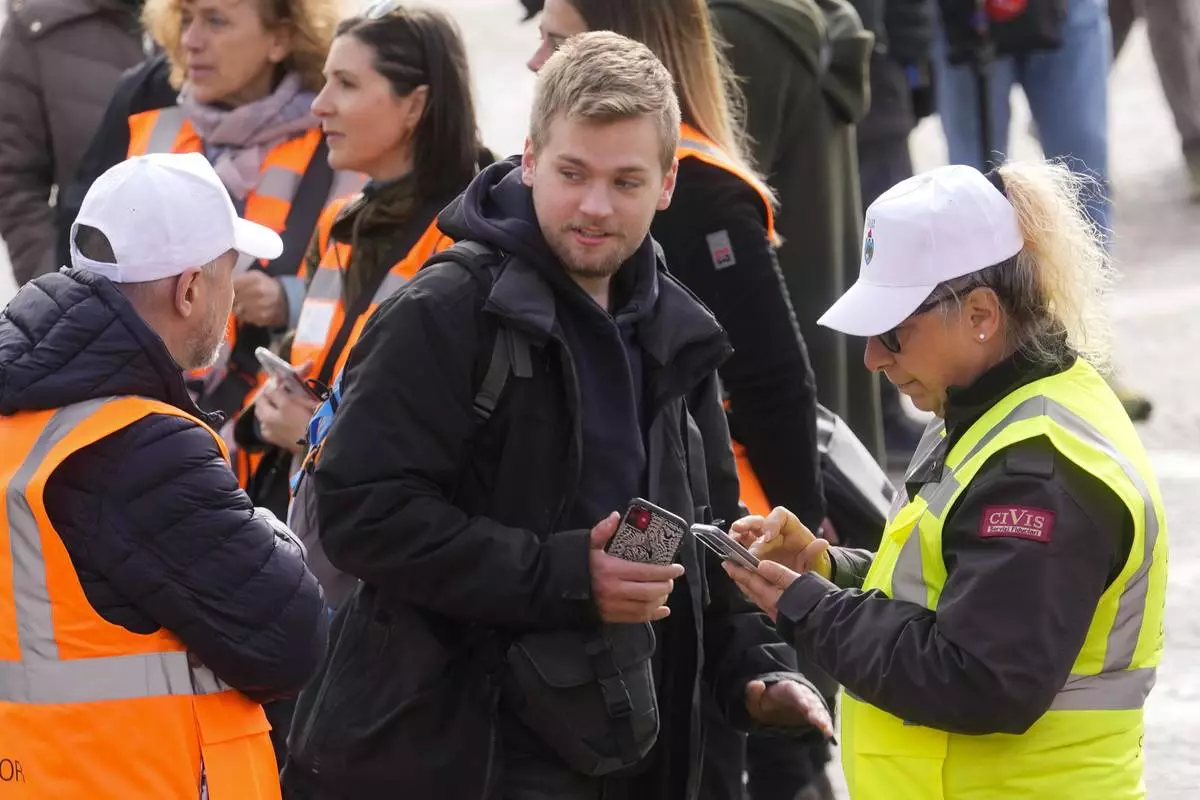
Stewards check a tourist QR code access outside the main train station in Venice, Italy, Thursday, April 25, 2024. The fragile lagoon city of Venice begins a pilot program Thursday to charge daytrippers a 5 euro entry fee that authorities hope will discourage tourists from arriving on peak days. The daytripper tax is being tested on 29 days through July, mostly weekends and holidays starting with Italy's Liberation Day holiday Thursday. Officials expect some 10,000 people will pay the fee to access the city on the first day, downloading a QR code to prove their payment, while another 70,000 will receive exceptions, for example, because they work in Venice or live in the Veneto region. (AP Photo/Luca Bruno)
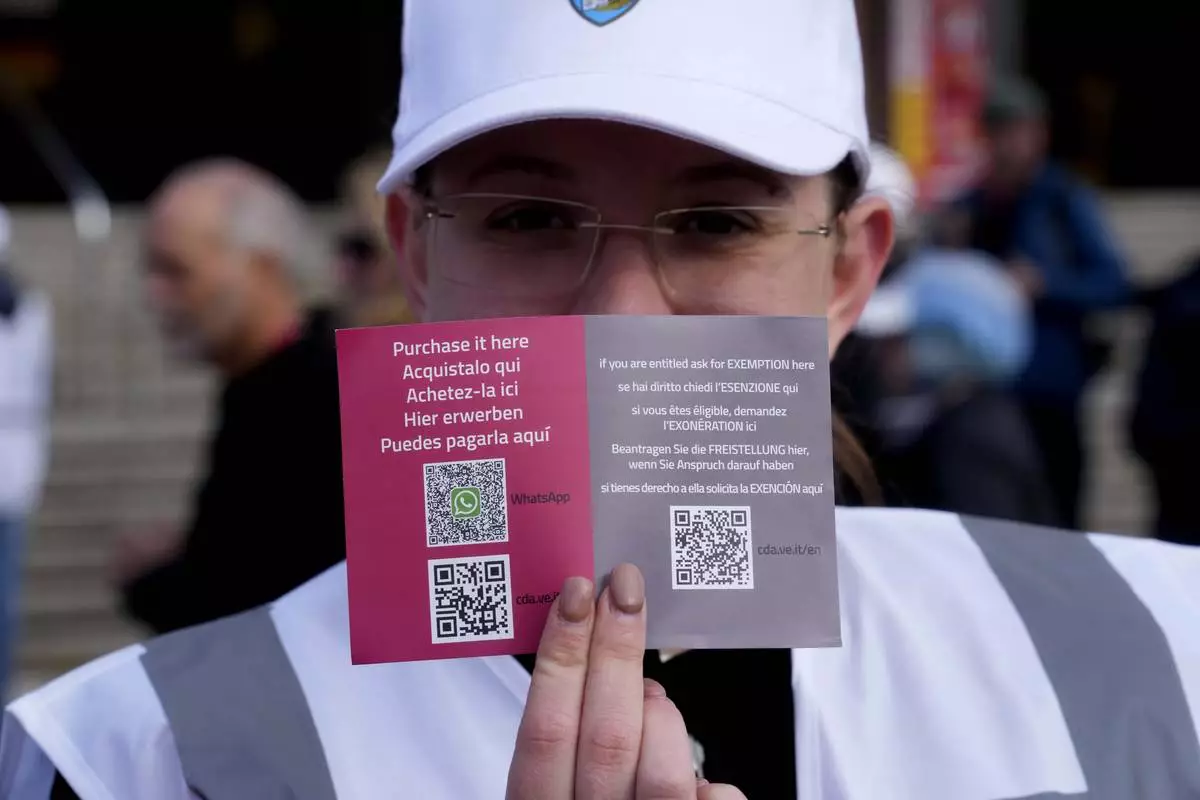
A steward shows the QR code access outside the main train station in Venice, Italy, Thursday, April 25, 2024. The fragile lagoon city of Venice begins a pilot program Thursday to charge daytrippers a 5 euro entry fee that authorities hope will discourage tourists from arriving on peak days. The daytripper tax is being tested on 29 days through July, mostly weekends and holidays starting with Italy's Liberation Day holiday Thursday. Officials expect some 10,000 people will pay the fee to access the city on the first day, downloading a QR code to prove their payment, while another 70,000 will receive exceptions, for example, because they work in Venice or live in the Veneto region. (AP Photo/Luca Bruno)
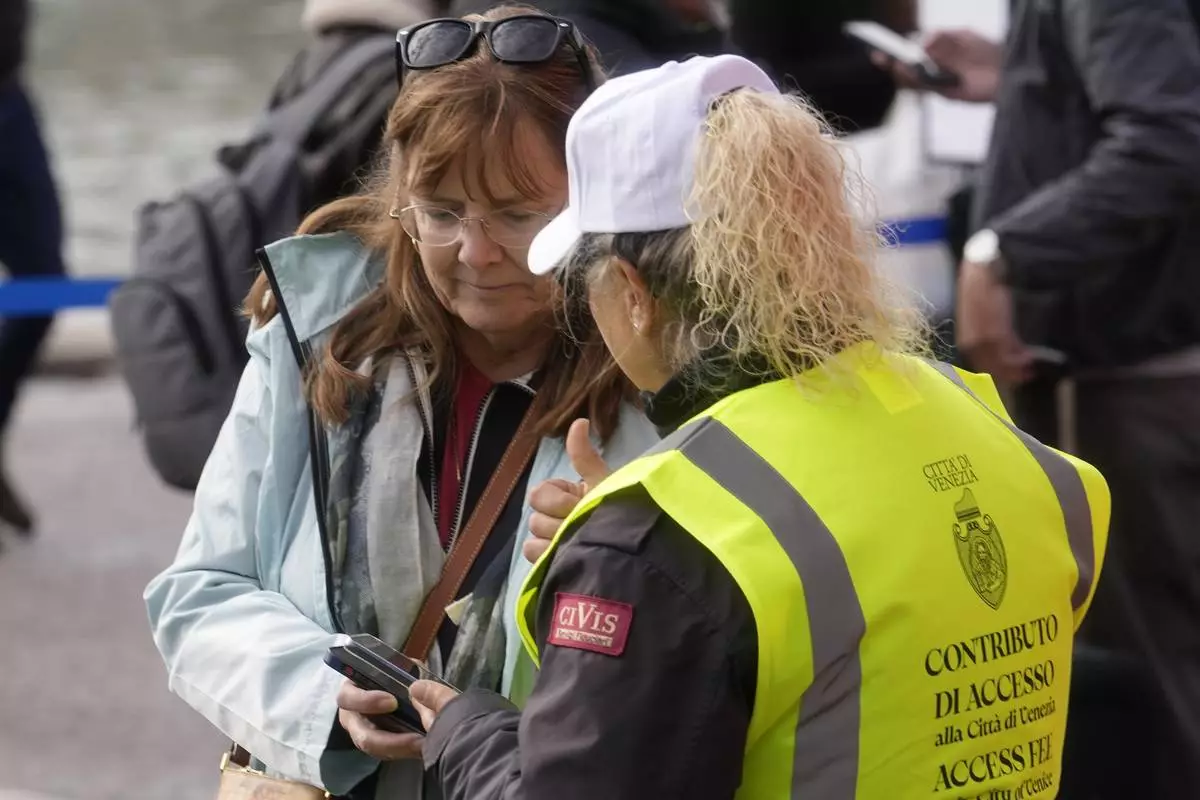
A steward checks a tourist QR code access outside the main train station in Venice, Italy, Thursday, April 25, 2024. The fragile lagoon city of Venice begins a pilot program Thursday to charge daytrippers a 5 euro entry fee that authorities hope will discourage tourists from arriving on peak days. The daytripper tax is being tested on 29 days through July, mostly weekends and holidays starting with Italy's Liberation Day holiday Thursday. Officials expect some 10,000 people will pay the fee to access the city on the first day, downloading a QR code to prove their payment, while another 70,000 will receive exceptions, for example, because they work in Venice or live in the Veneto region. (AP Photo/Luca Bruno)
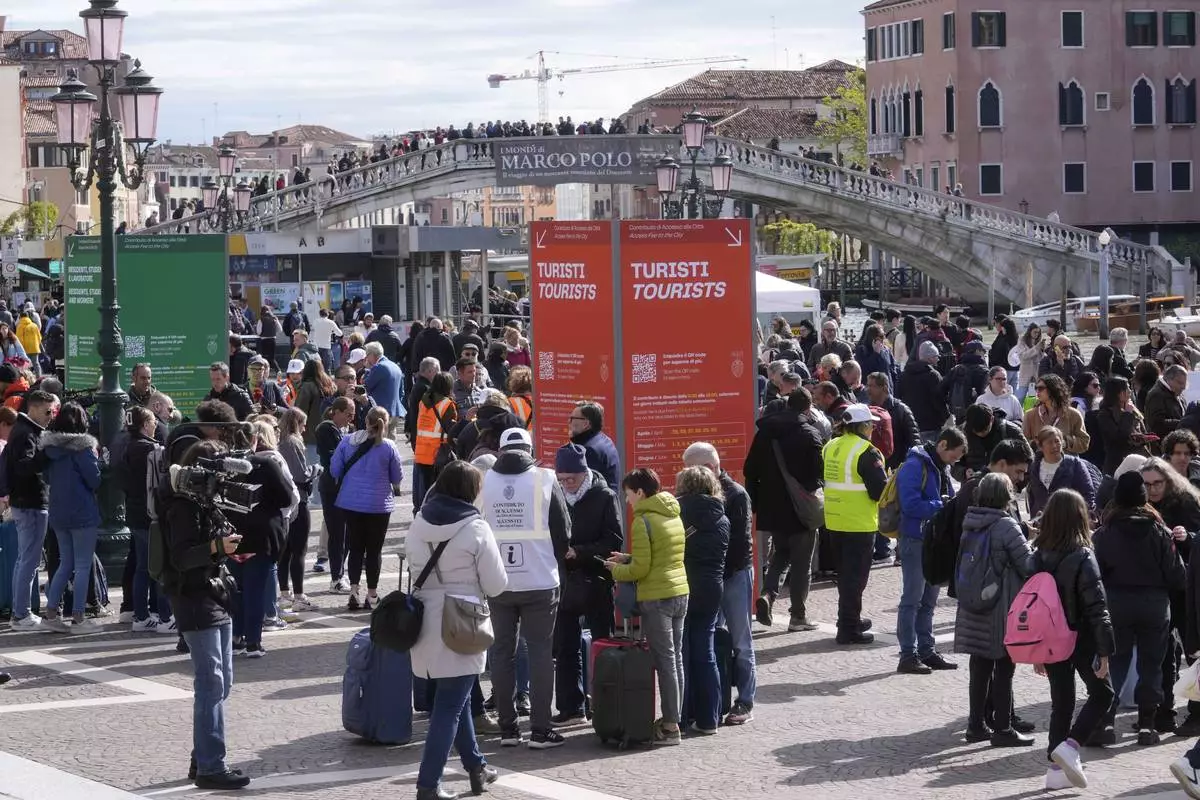
Stewards check tourists QR code access outside the main train station in Venice, Italy, Thursday, April 25, 2024. The fragile lagoon city of Venice begins a pilot program Thursday to charge daytrippers a 5 euro entry fee that authorities hope will discourage tourists from arriving on peak days. The daytripper tax is being tested on 29 days through July, mostly weekends and holidays starting with Italy's Liberation Day holiday Thursday. Officials expect some 10,000 people will pay the fee to access the city on the first day, downloading a QR code to prove their payment, while another 70,000 will receive exceptions, for example, because they work in Venice or live in the Veneto region. (AP Photo/Luca Bruno)
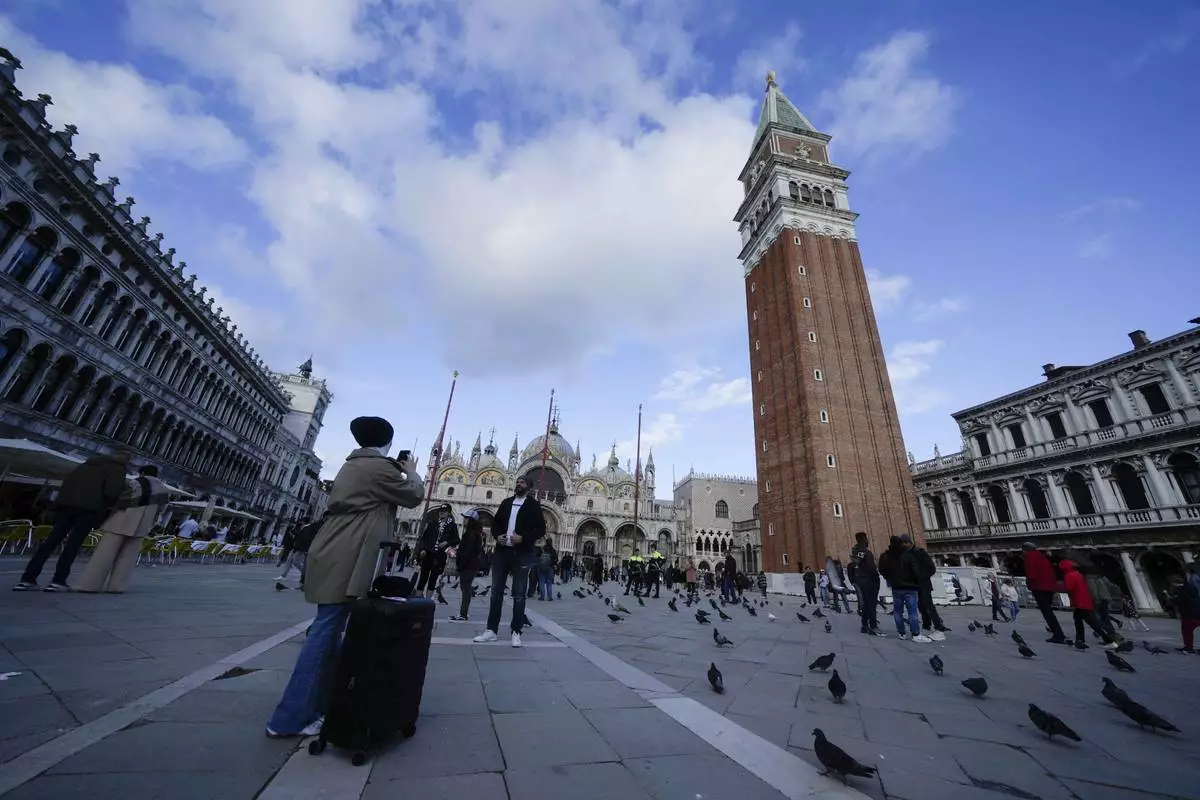
Tourists take pictures at the St. Mark square in Venice, Italy, Wednesday, April 24, 2024. The lagoon city of Venice begins a pilot program Thursday, April 25, 2024 to charge daytrippers a 5 euro entry fee that authorities hope will discourage tourists from arriving on peak days. Officials expect some 10,000 people will pay the fee to access the city on the first day, downloading a QR code to prove their payment. (AP Photo/Luca Bruno)
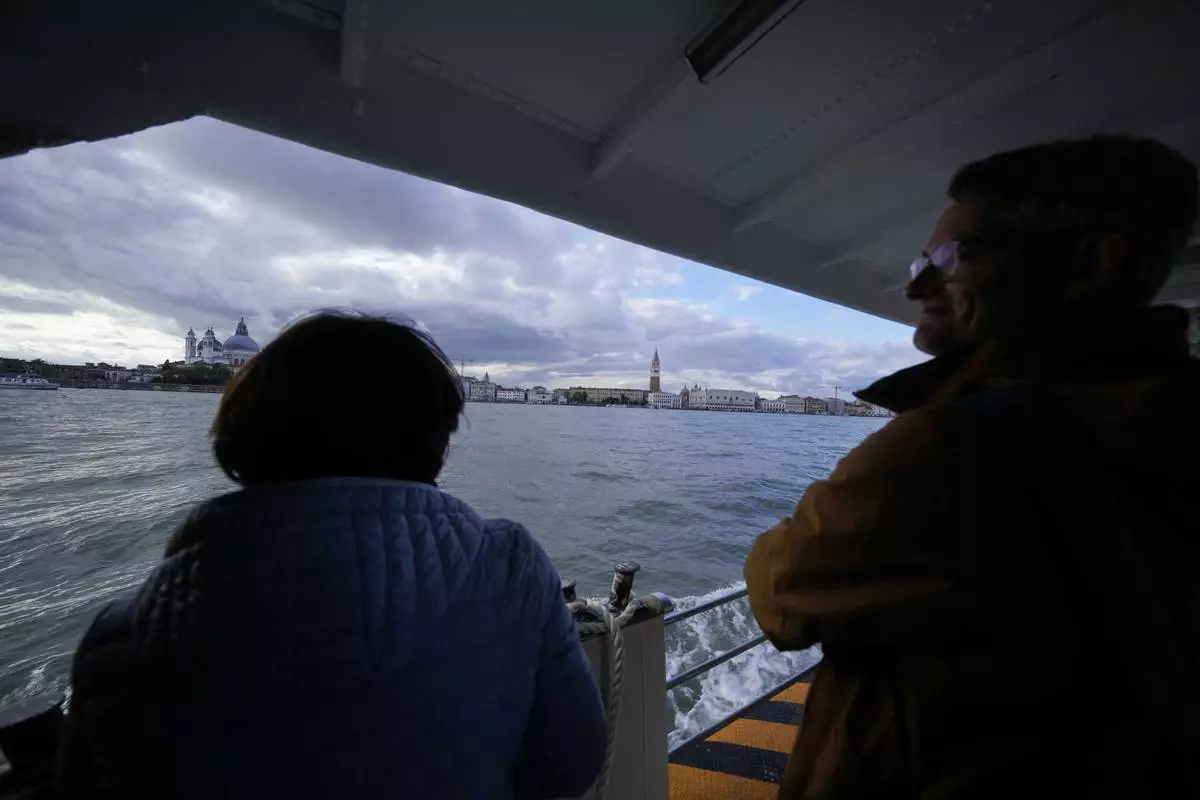
Tourists ride on a ferry boat in Venice, Italy, Wednesday, April 24, 2024. The lagoon city of Venice begins a pilot program Thursday, April 25, 2024 to charge daytrippers a 5 euro entry fee that authorities hope will discourage tourists from arriving on peak days. Officials expect some 10,000 people will pay the fee to access the city on the first day, downloading a QR code to prove their payment. (AP Photo/Luca Bruno)
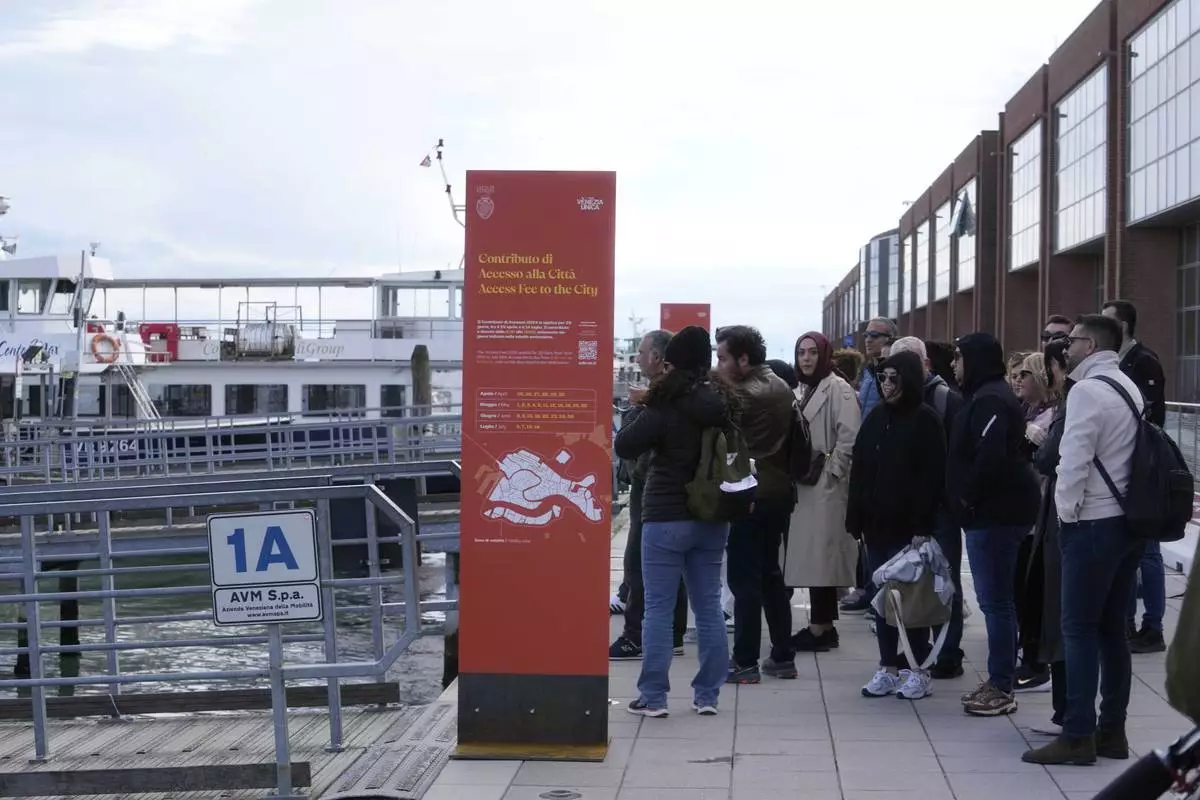
People stand in front of an information board explaining how to pay the tourist tax in Venice, Italy, Wednesday, April 24, 2024. The lagoon city of Venice begins a pilot program Thursday, April 25, 2024 to charge daytrippers a 5 euro entry fee that authorities hope will discourage tourists from arriving on peak days. Officials expect some 10,000 people will pay the fee to access the city on the first day, downloading a QR code to prove their payment. (AP Photo/Luca Bruno)
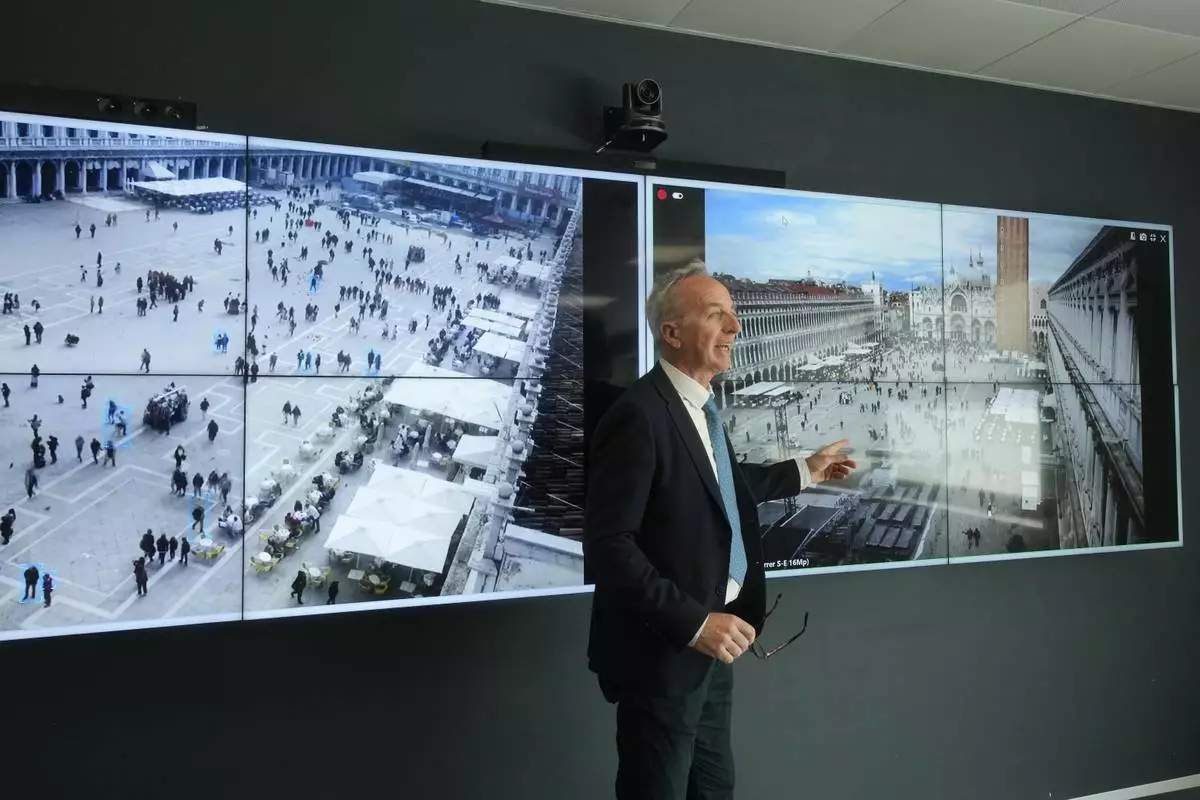
Marco Bettini, director of Venis Informatics System, gestures as he talks to reporters at the police Venice control room, in Venice, Italy, Wednesday, April 24, 2024. The lagoon city of Venice begins a pilot program Thursday, April 25, 2024 to charge daytrippers a 5 euro entry fee that authorities hope will discourage tourists from arriving on peak days. Officials expect some 10,000 people will pay the fee to access the city on the first day, downloading a QR code to prove their payment. (AP Photo/Luca Bruno)

Venice councillor Simone Venturini speaks with reporters in front of a tourist tax totem in Venice, Italy, Wednesday, April 24, 2024. The lagoon city of Venice begins a pilot program Thursday, April 25, 2024 to charge daytrippers a 5 euro entry fee that authorities hope will discourage tourists from arriving on peak days. Officials expect some 10,000 people will pay the fee to access the city on the first day, downloading a QR code to prove their payment. (AP Photo/Luca Bruno)
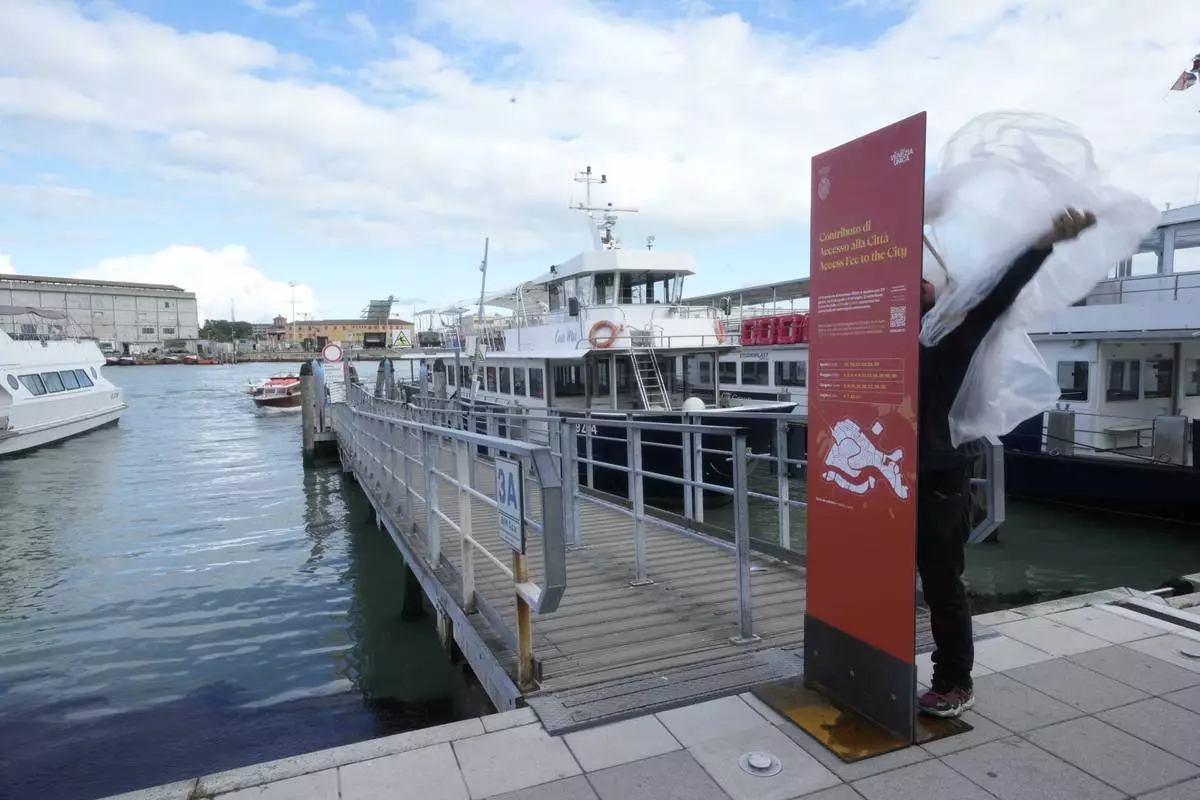
Workers prepare banner explaining how to pay the tourist tax in Venice, Italy, Wednesday, April 24, 2024. The lagoon city of Venice begins a pilot program Thursday, April 25, 2024 to charge daytrippers a 5 euro entry fee that authorities hope will discourage tourists from arriving on peak days. Officials expect some 10,000 people will pay the fee to access the city on the first day, downloading a QR code to prove their payment. (AP Photo/Luca Bruno)

Marco Bettini, director of Venis Informatics System, gestures as he explains the Venice density to reporters at the police Venice control room in Venice, Italy, Wednesday, April 24, 2024. The lagoon city of Venice begins a pilot program Thursday, April 25, 2024 to charge daytrippers a 5 euro entry fee that authorities hope will discourage tourists from arriving on peak days. Officials expect some 10,000 people will pay the fee to access the city on the first day, downloading a QR code to prove their payment. (AP Photo/Luca Bruno)
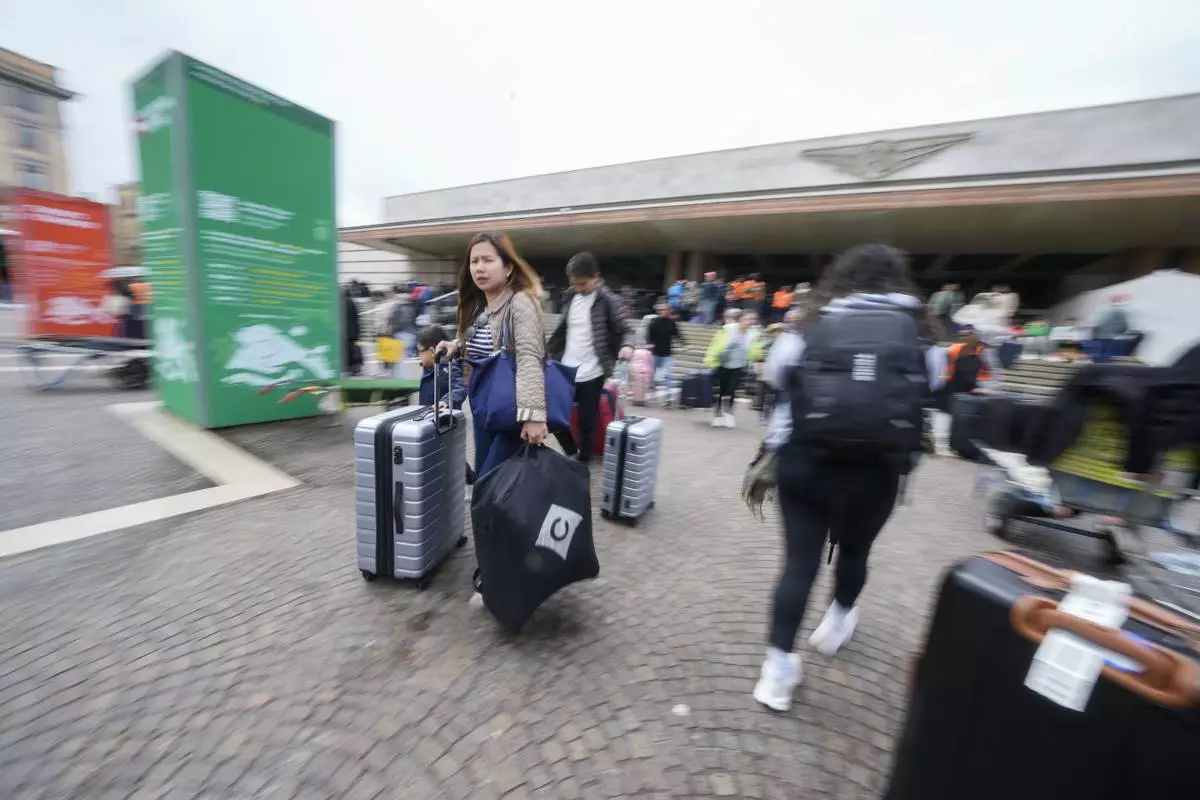
Tourists arrive at the main train station in Venice, Italy, Wednesday, April 24, 2024. The lagoon city of Venice begins a pilot program Thursday, April 25, 2024 to charge daytrippers a 5 euro entry fee that authorities hope will discourage tourists from arriving on peak days. Officials expect some 10,000 people will pay the fee to access the city on the first day, downloading a QR code to prove their payment. (AP Photo/Luca Bruno)
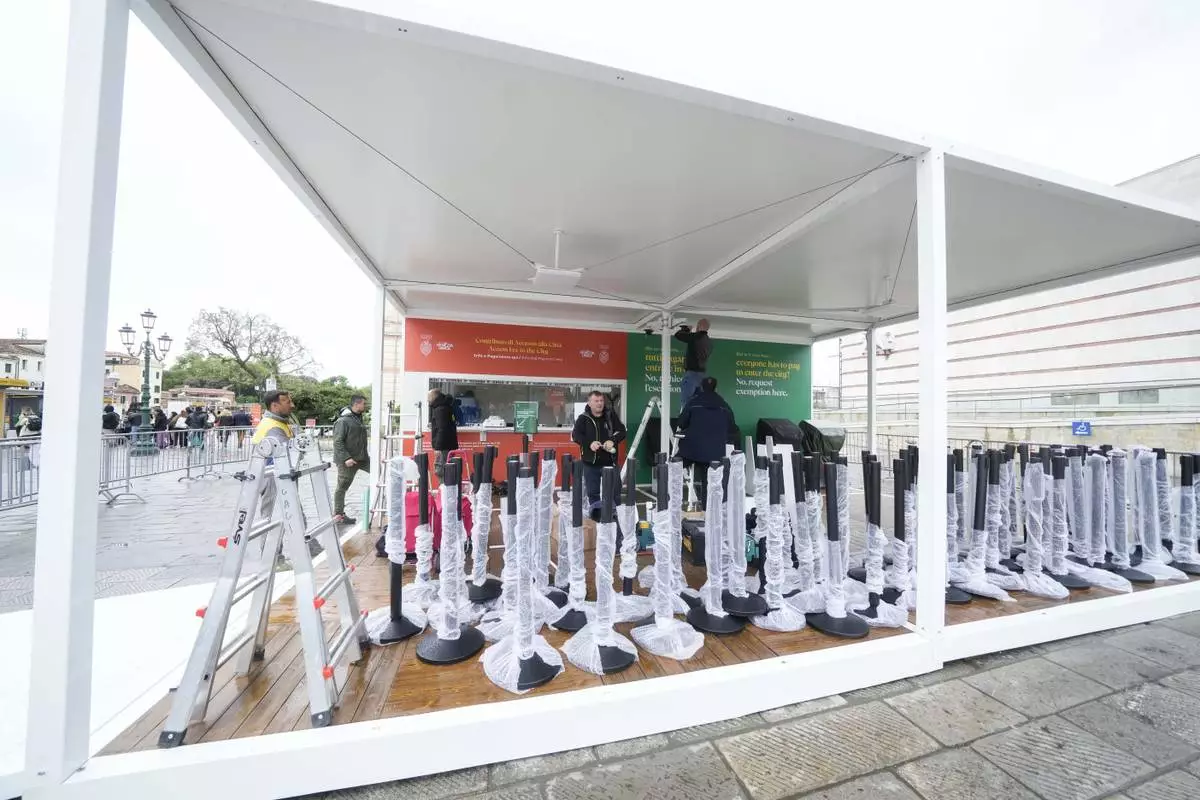
Workers prepare the tourist tax cashier desks outside the main train station in Venice, Italy, Wednesday, April 24, 2024. The lagoon city of Venice begins a pilot program Thursday, April 25, 2024 to charge daytrippers a 5 euro entry fee that authorities hope will discourage tourists from arriving on peak days. Officials expect some 10,000 people will pay the fee to access the city on the first day, downloading a QR code to prove their payment. (AP Photo/Luca Bruno)
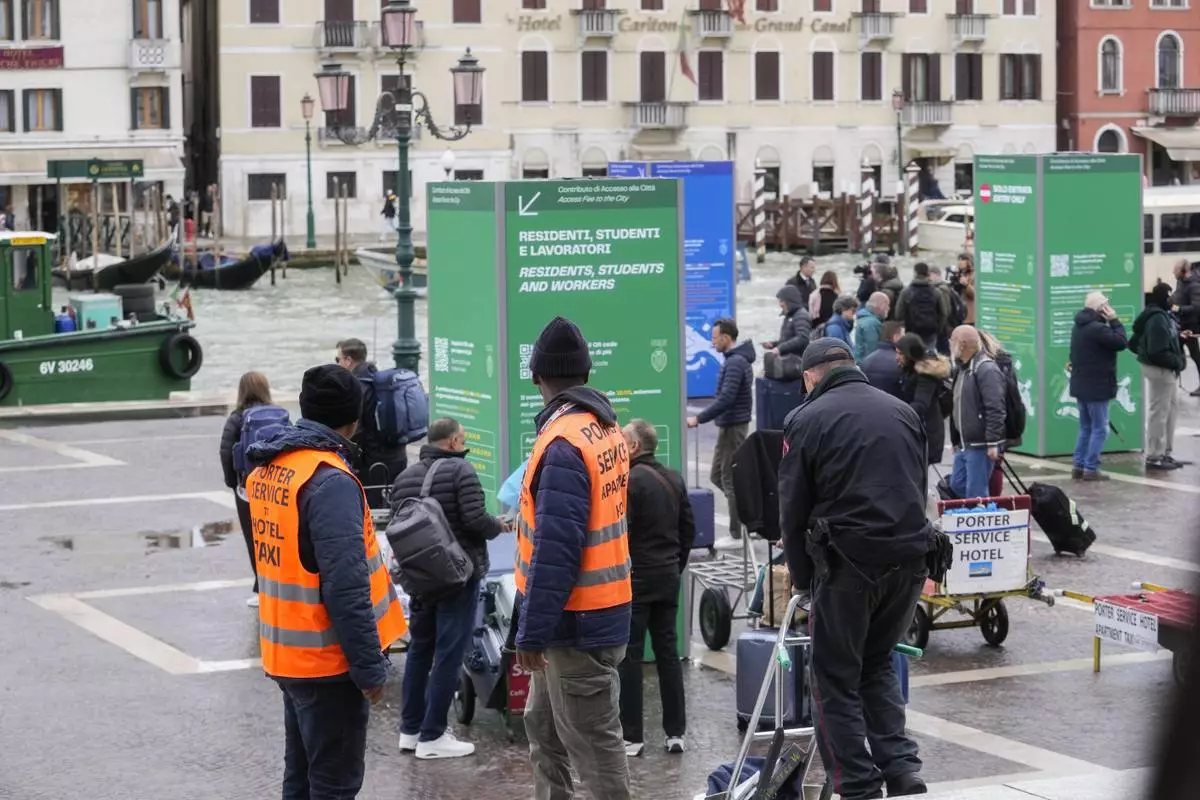
Porters wait for tourists outside the main train station in Venice, Italy, Wednesday, April 24, 2024. The lagoon city of Venice begins a pilot program Thursday, April 25, 2024 to charge daytrippers a 5 euro entry fee that authorities hope will discourage tourists from arriving on peak days. Officials expect some 10,000 people will pay the fee to access the city on the first day, downloading a QR code to prove their payment. (AP Photo/Luca Bruno)
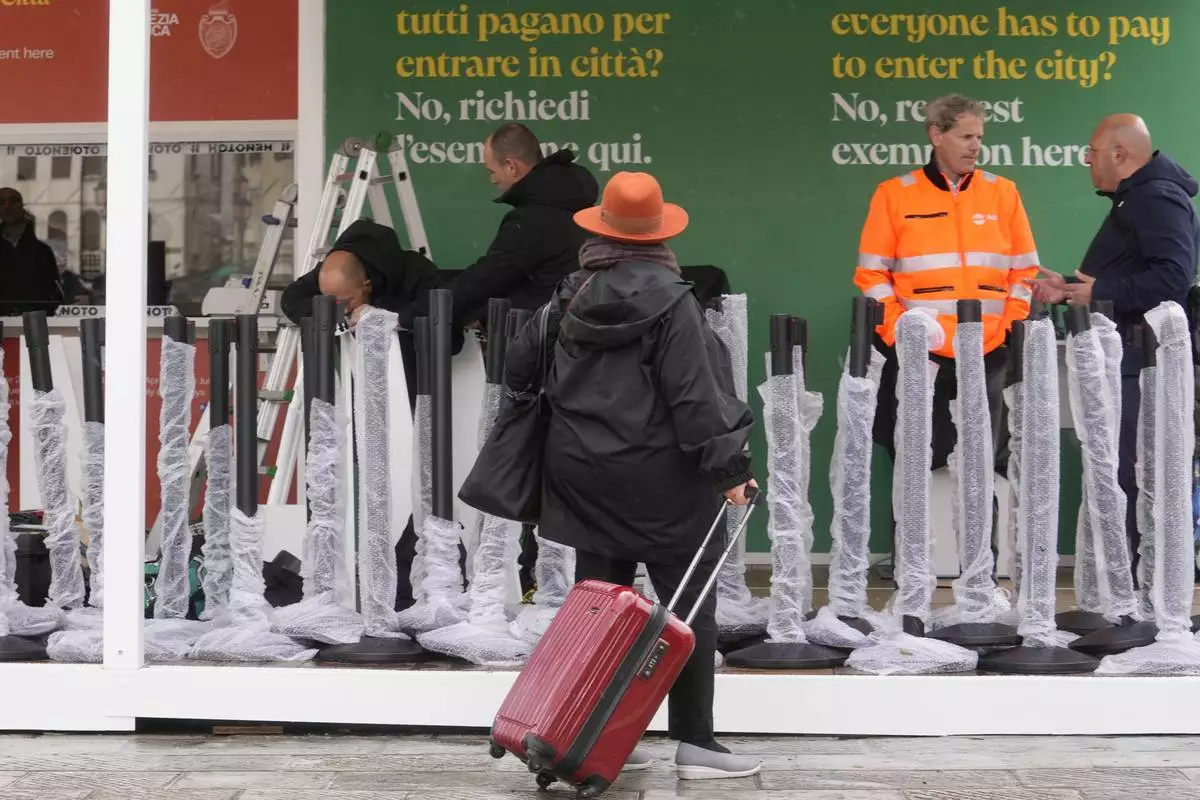
Workers prepare the tourist tax cashier desks outside the main train station in Venice, Italy, Wednesday, April 24, 2024. The lagoon city of Venice begins a pilot program Thursday, April 25, 2024 to charge daytrippers a 5 euro entry fee that authorities hope will discourage tourists from arriving on peak days. Officials expect some 10,000 people will pay the fee to access the city on the first day, downloading a QR code to prove their payment. (AP Photo/Luca Bruno)
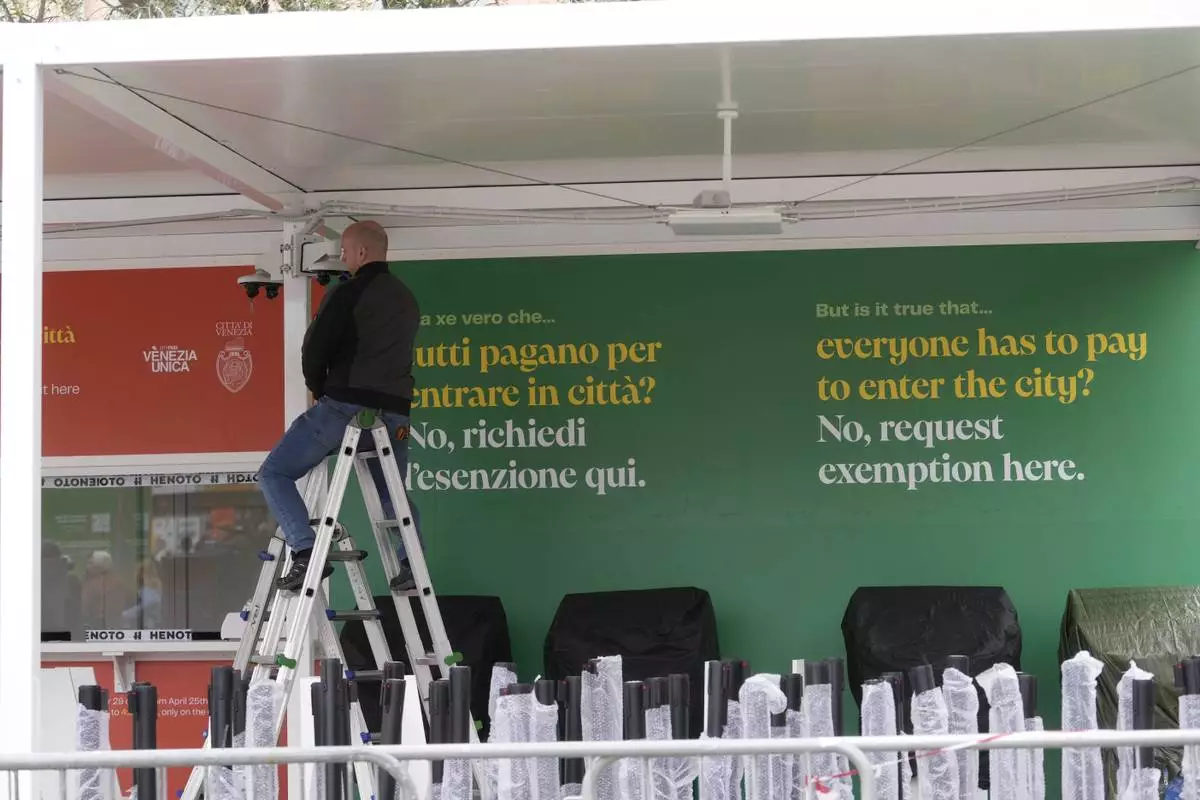
Workers prepare the tourist tax cashier desks outside the main train station in Venice, Italy, Wednesday, April 24, 2024. The lagoon city of Venice begins a pilot program Thursday, April 25, 2024 to charge daytrippers a 5 euro entry fee that authorities hope will discourage tourists from arriving on peak days. Officials expect some 10,000 people will pay the fee to access the city on the first day, downloading a QR code to prove their payment. (AP Photo/Luca Bruno)

Porters wait for tourists outside the main train station in Venice, Italy, Wednesday, April 24, 2024. The lagoon city of Venice begins a pilot program Thursday, April 25, 2024 to charge daytrippers a 5 euro entry fee that authorities hope will discourage tourists from arriving on peak days. Officials expect some 10,000 people will pay the fee to access the city on the first day, downloading a QR code to prove their payment. (AP Photo/Luca Bruno)
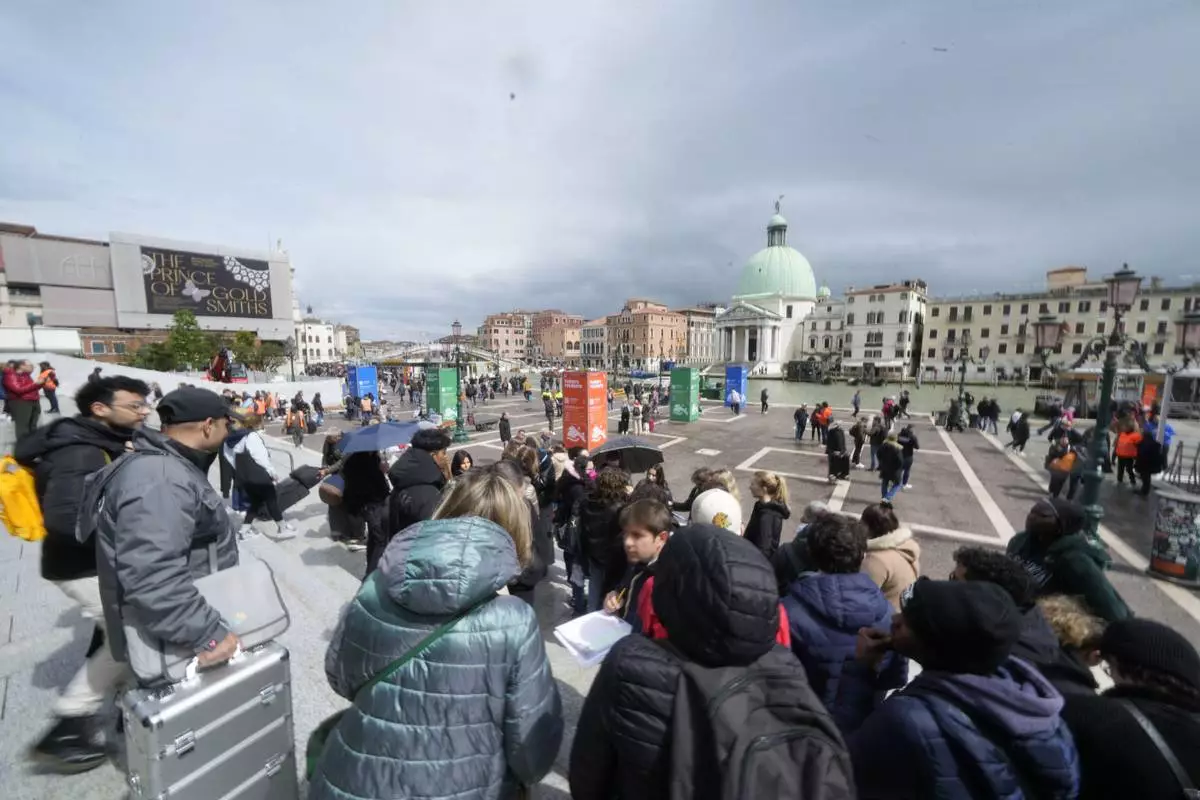
Tourists arrive outside the main train station in Venice, Italy, Wednesday, April 24, 2024. The lagoon city of Venice begins a pilot program Thursday, April 25, 2024 to charge daytrippers a 5 euro entry fee that authorities hope will discourage tourists from arriving on peak days. Officials expect some 10,000 people will pay the fee to access the city on the first day, downloading a QR code to prove their payment. (AP Photo/Luca Bruno)
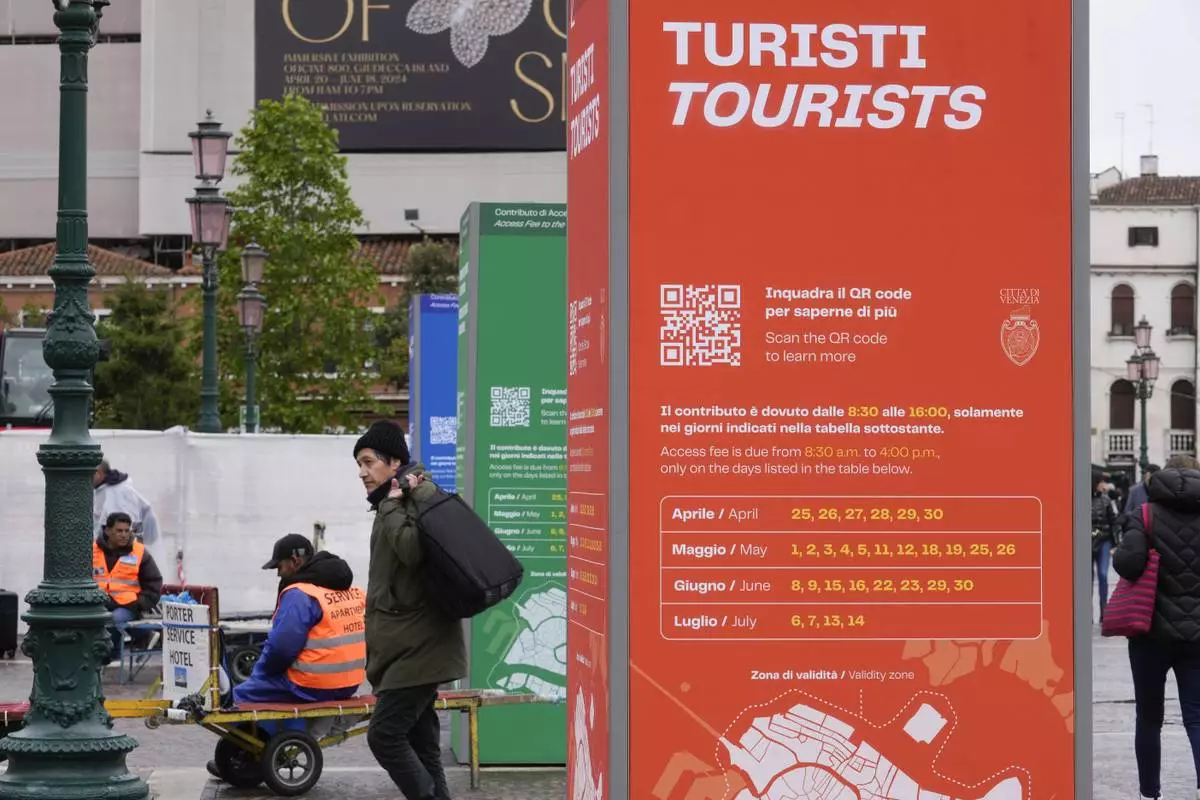
Tourist information boards are seen outside the main train station in Venice, Italy, Wednesday, April 24, 2024. The lagoon city of Venice begins a pilot program Thursday, April 25, 2024 to charge daytrippers a 5 euro entry fee that authorities hope will discourage tourists from arriving on peak days. Officials expect some 10,000 people will pay the fee to access the city on the first day, downloading a QR code to prove their payment. (AP Photo/Luca Bruno)
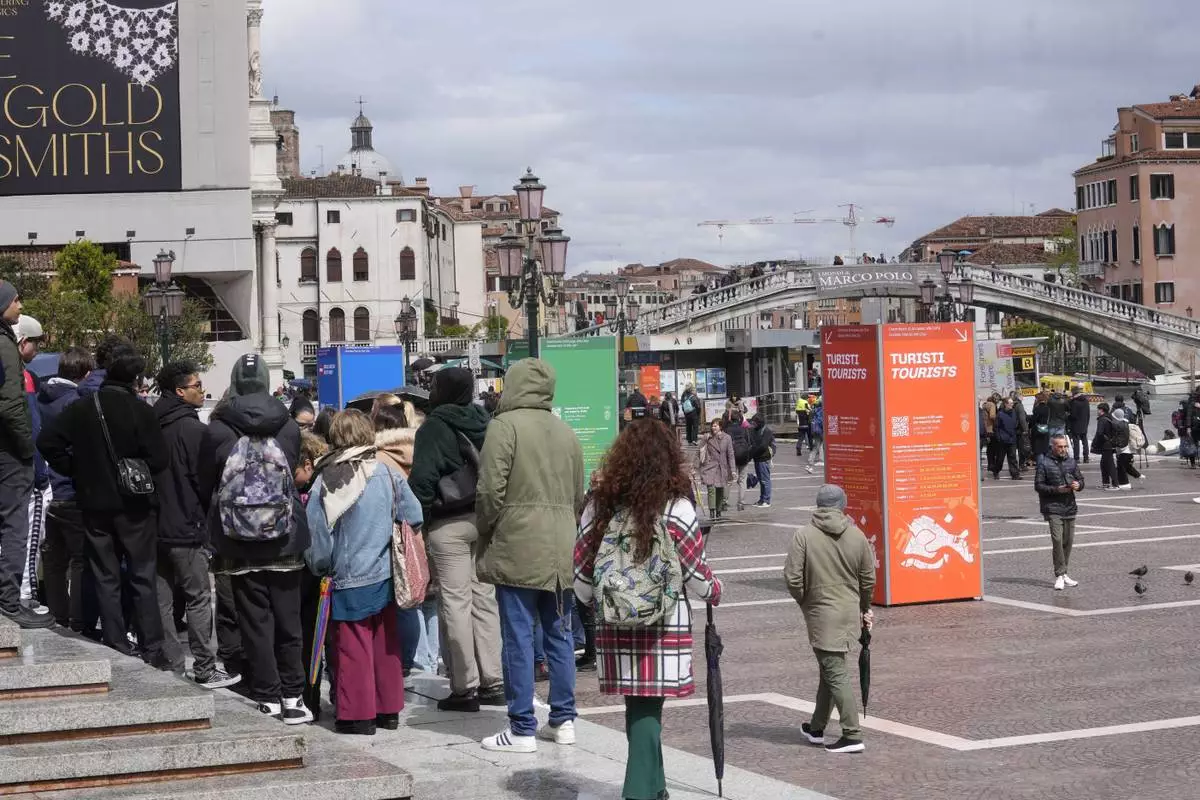
Tourists arrive outside the main train station in Venice, Italy, Wednesday, April 24, 2024. The lagoon city of Venice begins a pilot program Thursday, April 25, 2024 to charge daytrippers a 5 euro entry fee that authorities hope will discourage tourists from arriving on peak days. Officials expect some 10,000 people will pay the fee to access the city on the first day, downloading a QR code to prove their payment. (AP Photo/Luca Bruno)




































